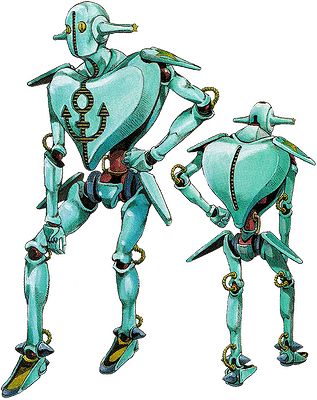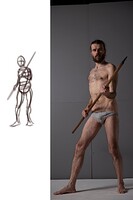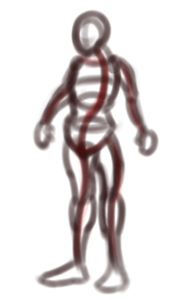The question is interesting, because it’s an opportunity to share and maybe learn something new from others!
Techniques
I mostly draw anime-style artwork, so usually it’s this: thumbnails → rough → lineart → flat shading → block shadows → soft shadows, textures, rendering → refined lineart, overpaint → post-processing.
Very often I don’t do all of these steps, or I finish with flats and simple shadow, it depends on how refined the artwork is supposed to be.
Inspiration
Honestly, I’m not too ambitious or trying to be original at this point. It’s been maybe 2 years since I started taking my digital drawing more seriously, and I still have a lot of basic stuff to learn and internalize. My main focus is achieving good execution and consistency. Likewise, I don’t care about my style yet. I’m sure that will eventually appear naturally.
I enjoy a lot of anime-like content: manga, light novels, anime, and games, so when I see something cool or that made an impression on me, I tend to pick that as a subject for my drawings. I like drawing fan-art because you can find a lot of references and the design is figured out for you, so you can only focus on the execution and interpretation.
Lastly, I tend to copy a lot as a practice and to understand why an image is good. And I watch a lot of videos by artists: tutorials, explanations, corrections, etc., that helps me get some ideas or to notice and fix my mistakes.
Process
Yes, definitely a visual library is helpful. By consuming the content, I can either visualize or recall what I liked and that helps me find the right reference or try to see the scene that I want to draw in my mind. I recommend having a lot of references at hand, especially for poses, expressions, gestures, and difficult details. Once I have a general idea for what I want to do, the rest of the process is rather technical. Finding the right composition, building the mannequin for the characters… this is where you need to use references or have solid fundamentals and mileage to rely on.
Brushes and technical stuff
For starters, I recommend building a comfortable and ergonomic setup. I prefer a pen tablet (no screen), have a keyboard nearby and two big monitors to use for Krita and the references. This is my ideal configuration. Honestly, nothing beats the experience of painting freely on a 4K 144Hz screen, without your hand getting in a way, sitting up straight, and having your full keyboard at hand. I love it 
In Krita, I really only rely on a single plugin, Shortcut Composer. This is an indispensable plugin that offers many features, such as the tool pie menu popups, tools cycled on a single hot key, and many other enhancements. This is all about one thing - creating your own seamless experience, where you can focus on your canvas and just use everything that you need without thinking about it. I would guess that I can do 90% of my painting with just the shortcuts. When I start using menus, it is mostly to go through a lot of brushes, tweak tool settings, or invoke some unusual filters/modes.
Regarding some specifics:
-
My very often used actions/tools (on hotkeys)
- brush/eraser/swap the last two brushes
- lasso/rect select
- color picker popup
- pick color, pick layer, scrub through the layers
- insert, merge down, reorder, hide/show layers
- pan/rotate/zoom/reset canvas
- change brush size
- fill
- transform/translate
- crop
- adjust HSV (good to lighten/darken a value or to try a different color)
-
Brushes
- h) Charcoal Pencil Thin - perfect for lineart
- b) Basic-1 - flat fill, eraser
- d) Ink-4 Pen Rough - really great for sharp inked lines
- d) Ink-3 Gpen - for getting a solid and smooth lineart (I usually prefer charcoal though)
- b) Basic-6 Details - good for highlights and similar small things
- b) Airbrush Soft - for bigger gradients, glow effects, used very sparingly
- David Revoy’s brushes
- a1) Eraser Tip - an eraser that can leave a bit of opacity if needed
- d) Glazing Textured - absolutely love it for painting, especially over the flat base
- d) Charcoal Rock Soft - very good to paint a color rough
- Ramon Miranda’s ink brushes - have been using them lately for Inktober
- inkP 02 Worn Out GPen - like the standard rough pen, but softer, amazing for hatching
- the inkT bundle has a lot of great textured brushes
I would generally recommend experimenting with all the brushes in the packs mentioned above. When I’m in the rendering stage of the painting, I tend to switch between them quite chaotically, until I find something that feels good in a given setting. Textured brushes can be a godsend to quickly get a convincing rendering, especially on a large area, like a stone wall, a tree trunk, foliage. Without it, painting such things can be a daunting task. I yet have to dabble into stuff like watercolor, or other realistic-like brushes, I haven’t tried these effects yet.
Oops, and here I went and wrote an essay. Sorry for that  Don’t feel obligated to read
Don’t feel obligated to read  Cheers.
Cheers.


